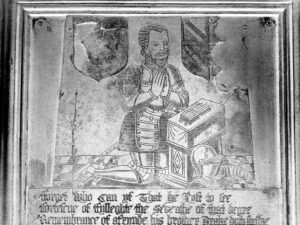On this day in Tudor history, 10th April 1586, in the reign of Queen Elizabeth I, sea captain Sir Bernard Drake died in Crediton, Devon, from probable typhus.
It appears that Drake caught the disease from Portuguese prisoners whose ships, laden with Brazilian sugar, he’d captured on his voyage to the West Indies.
But who was Sir Bernard Drake and was he related to the more famous Sir Francis Drake?
Here are a few facts about this Tudor sea captain…
- Drake was born in around 1537 and was the eldest son of John Drake of Ash in Devon, and his wife, Amy Grenville.
- He was married to Gertrude Fortescue and they had 6 children together, three sons and three daughters.
- Through his mother, Drake was related to sea captain Sir Richard Grenville, and explorers Sir Walter Raleigh and Sir Humphrey Gilbert.
- In December 1582, Drake invested in a corporation established by Gilbert, and then, in 1585, he, Raleigh and Gilbert’s brother, John, in activities associated with the newly founded Roanoke Colony in North Carolina.
- Also in 1585, following Spain putting an embargo on English shipping in its ports, Elizabeth I’s privy council authorised Raleigh to organise ships to be sent to the Newfoundland fishing grounds to warn English ships not to take fish to Spanish or Portuguese ports and to seize any Spanish ships in the area. Drake and Raleigh’s brother, Carew Raleigh, were commissioned to lead these expeditions to Newfoundland. Drake’s plans for an expedition to Roanoke, with some privateering in the West Indies on the way, were scuppered, and he left for the Newfoundland fisheries in July 1585.
- En route to Newfoundland, Drake captured the Portuguese ship laden with Brazilian sugar, and, after warning English ships in Newfoundland of the Spanish embargo, he went on to capture Spanish and Portuguese fishing ships. Then, with George Raymond, an associate of Raleigh, he set sail for the Azores, where they captured Spanish ships laden with sugar, wine and ivory, and a French ship laden with gold.
- After successfully taking much of it back to England, Drake and his son, John, Raleigh and Gilbert rewarded Drake and his son, John, with 4 of the ships. Drake had captured some Portuguese sailors, bringing them back to England and having them imprisoned at Exeter Castle.
- Drake was knighted by the queen on 9th January 1586 at Greenwich. However, in March 1586, the judge at the Exeter assize reprimanded Drake for neglect as the Portuguese prisoners who were put on trial were in a bad state. This assize became known as the Lent Black Assize of Exeter because 8 justice of the peace, 11 jurors and several constables died of gaol fever, or typhus, which they caught from the prisoners. It also affected the local population. Drake also contracted it and died at Crediton on 10th April 1586 on his journey home. His son, John, inherited the family home at Ash and the proceeds of their successful voyage to Newfoundland.
- Was Bernard Drake related to Francis Drake?
Yes, distantly. In 1581, there was trouble between the two Drakes when Francis Drake assumed the arms of Drake of Ashe, arms used by Bernard’s family. The story is told in John Prince’s 1697 Worthies of Devon:
“By the assumption of the arms of the family of Ash, Sir Francis Drake incurr'd the displeasure of Sir Bernard, insomuch that Sir Francis receiv'd from the indignant knight a box on the ear, and that even within the precinct of the court. The Queen was of too haughty a spirit to permit such an outrage to pass unpunish'd and not only reprehended Sir Bernard but as a check to the pride of the one and as what was due to the merit of the other, bestow'd on Sir Francis a new coat of arms allusive to his having circumnavigated the world...”
Also on this day in Tudor history...




Leave a Reply